NCERT Based Activity: Health: The Ultimate Treasure | Science Curiosity Class 8 - New NCERT PDF Download
Activity 3.1: Let us read
A Grade 8 student moved to a new school in another city. With no friends in his new environment and busy parents, he felt lonely. To cope, he spent more time on his phone and social media, but this made him feel worse. He stopped trying to make friends, had headaches, lost weight, and could not sleep well. A doctor advised less screen time and meeting a counsellor. The school counsellor arranged help to support him in making friends and improving his health.
Think and Reflect: What was the cause of the boy’s health problems?
Ans: The cause of the boy’s health problems was loneliness due to moving to a new school and having no friends, compounded by excessive screen time and social media use, which worsened his mental and physical health.
How did his habits and surroundings affect his well-being?
Ans: His habit of excessive screen time increased his loneliness, leading to headaches, weight loss, and sleep issues. His surroundings, with busy parents and no friends, lacked social support, negatively impacting his mental and physical well-being.
Activity 3.2: Let us list
List some good habits that your parents, teachers, or elders often encourage you to follow. How many of these are already a part of your daily routine? Which ones would you like to start following? Add to the list below:
- Keep yourself clean and maintain personal hygiene.
- Eat a healthy and balanced diet.
- Exercise regularly.
- Make time to relax or meditate every day.
Here’s an extended list of good habits that parents, teachers, or elders often encourage us to follow:
- Be honest and truthful.
- Finish your homework and tasks on time.
- Read books and newspapers daily.
- Save water, electricity, and other resources.
- Help at home with small chores.

1. How many of these are already a part of your daily routine?
Ans: Answers may vary; for example, keeping clean and eating a balanced diet might be routine, while exercising or meditating might not.
2. Which ones would you like to start following?
Ans: Answers may vary; for example, starting regular exercise or daily meditation.
Now, think about habits that are not good for your health. Add more to the list below:
- Spending too much time on mobile phones or other digital screens.
- Eating fast food and other junk food every day.
- Sleeping very late or not getting enough sleep.
- Skipping meals, especially breakfast.
3. Add more habits that are not good for your health.
Ans: Examples include smoking, excessive consumption of sugary drinks, or avoiding physical activity.
Activity 3.3: Let us compare
Look at Fig. 3.3a and Fig. 3.3b. Which playground would you like to play in, and why?
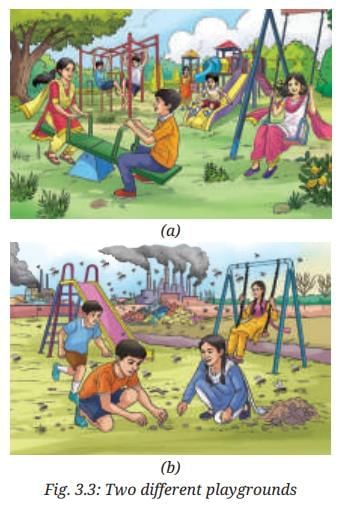 1. Which playground would you like to play in, and why?
1. Which playground would you like to play in, and why?
Ans: I would prefer to play in the playground shown in Fig. 3.3a because it is clean, well-maintained, and beautiful, making it a safe and enjoyable place.
2. Most of us would like to play in the playground shown in Fig. 3.3a as it is clean, well-maintained, and looks beautiful. The playground in Fig. 3.3b is polluted, dirty, unhygienic, and full of flies and mosquitoes. People living in such areas may fall sick more often.
3. Have you ever found it hard to breathe in a place with a lot of smoke or dust?
Ans: Yes, it can be hard to breathe in smoky or dusty areas, which may cause coughing or asthma due to poor air quality.
Activity 3.4: Let us find out
- Grade 8 students listed some common communicable diseases in Table 3.1 during a community campaign and a library survey.
- Check the information listed by referring to books, trusted websites, or asking your science teacher. Add any missing details.
- Study the table and think about what simple steps can help prevent each disease.
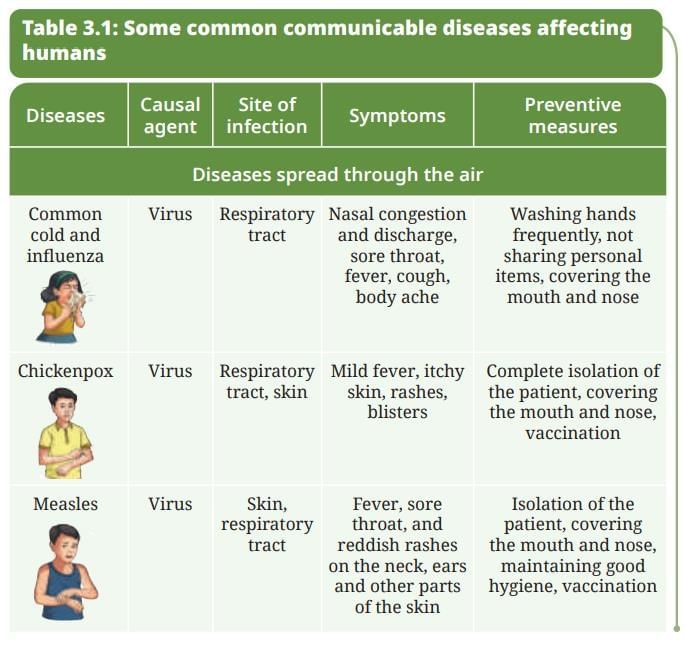

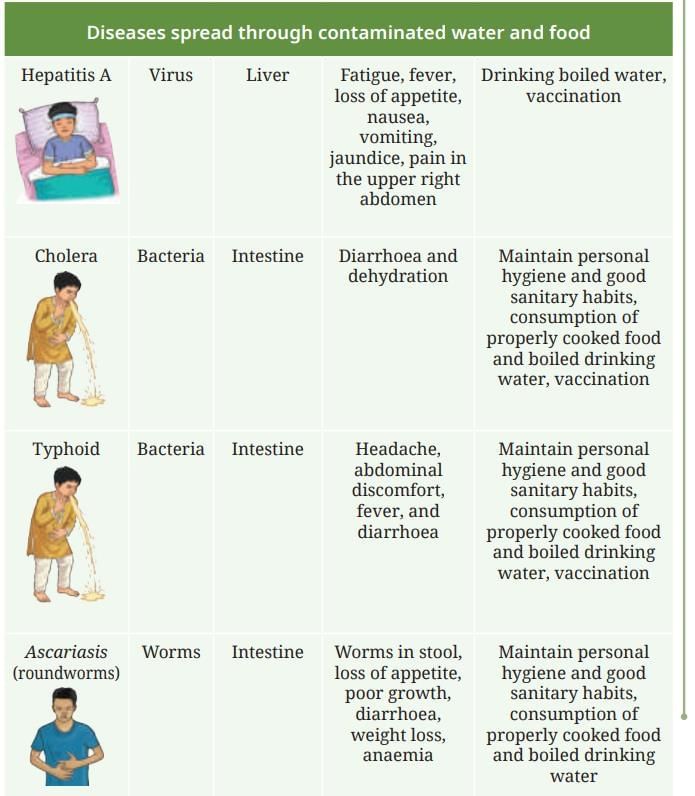
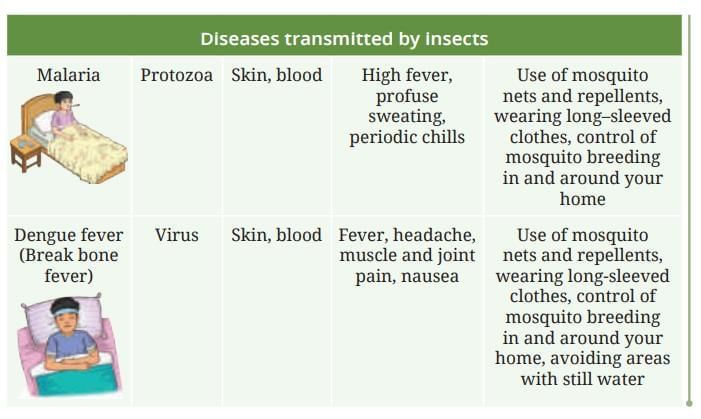
Simple steps to prevent most communicable diseases:
- Maintain personal hygiene (bathing, washing hands, trimming nails).
- Drink clean, boiled, or filtered water.
- Eat freshly cooked food.
- Take recommended vaccinations on time.
- Avoid contact with infected people.
- Use mosquito protection and prevent breeding sites.
Activity 3.5: Let us survey
- Find out the three most common lifestyle-related diseases in your neighbourhood.
- Talk to a doctor, nurse, health worker or even a family member who knows about health and what kind of lifestyle changes can help prevent or manage these diseases.
- You can also consult trusted health websites, books, teachers and doctors.
- Fill in Table 3.2 and learn more about lifestyle-related diseases.
Table 3.2: Non-communicable diseases (completed):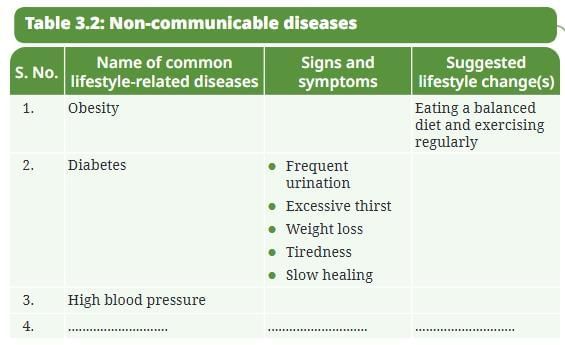
Ans: 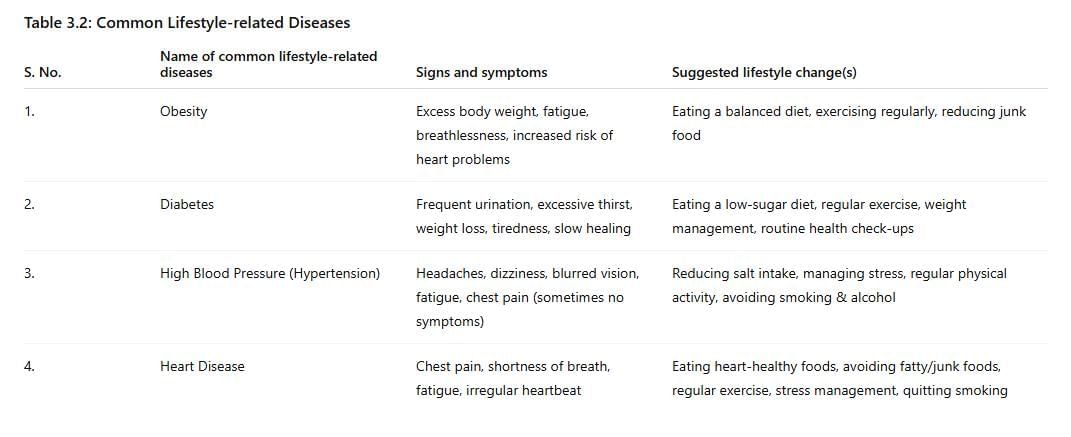
Activity 3.6: Let us read
Odisha — community-led sanitation campaign In Bhadrak district, Odisha, a community sanitation campaign helped more people build and use toilets. This reduced open defecation significantly, and improved child health, with fewer cases of diarrhoea and infections.
1. What do you infer from this case study?
Ans: Simple steps like good sanitation can greatly reduce the spread of communicable diseases, improving overall community health, especially for children.
2. Find about such community campaigns held in your location. Share in your class and discuss with your peers about the impact of such initiatives.
Ans: Example: Swachh Bharat Abhiyan in India promotes sanitation, reducing diseases like diarrhoea. Impact: Fewer infections, better hygiene, healthier communities. (Discuss: Campaigns lead to awareness, infrastructure, and behavior change for prevention.)
Activity 3.7: Let us infer
1. Study the infographic given in Fig. 3.5b. How do you think the antibiotic resistance has been developed in bacterial pathogens? What precautions may be taken to reduce antibiotic resistance?
Ans: Antibiotic resistance in bacterial pathogens develops when antibiotics are used too often or in the wrong way. Some bacteria survive the antibiotic treatment and become resistant, passing this resistance to other bacteria. Over time, these resistant bacteria multiply and the antibiotic no longer works against them.
Precautions to reduce antibiotic resistance:
- Take antibiotics only when prescribed by a doctor.
- Complete the full course of antibiotics as directed.
- Do not use leftover or shared antibiotics.
- Avoid misuse of antibiotics for viral infections like cold and flu.
- Maintain good hygiene and get vaccinated to prevent infections.
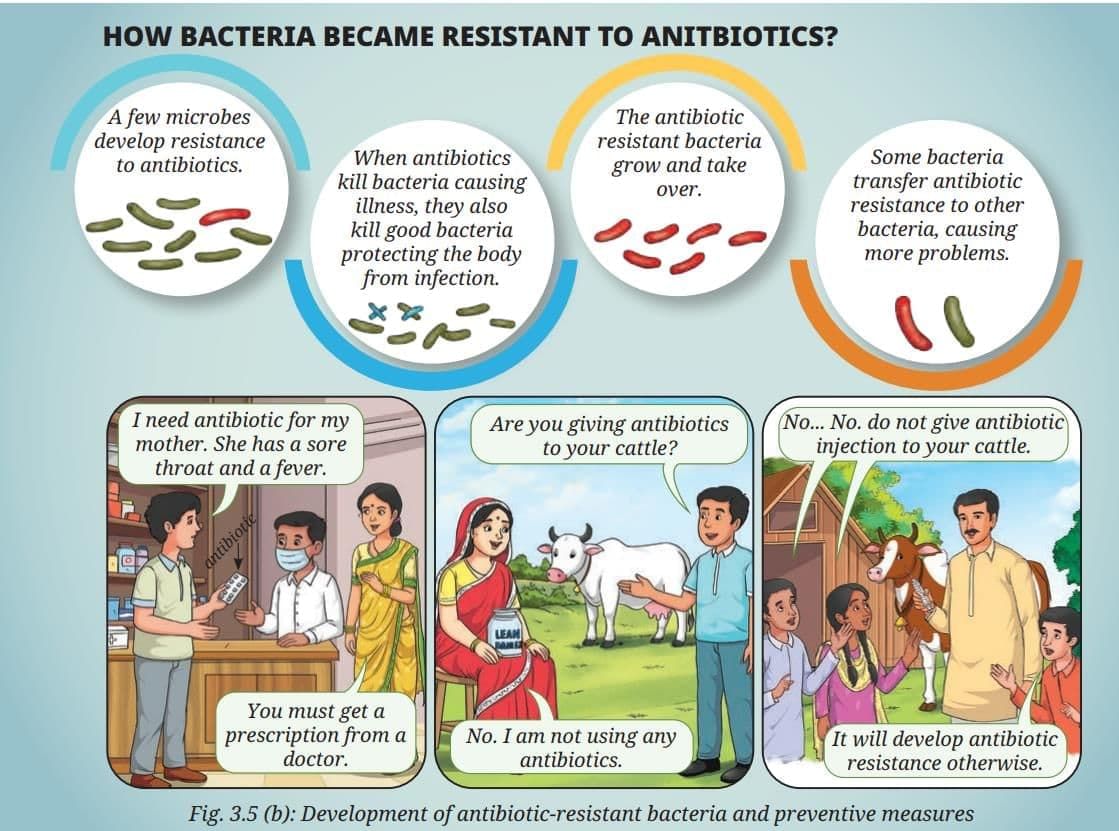
2. To tackle the problem of antibiotic resistance, we must use antibiotics wisely—only when prescribed by a doctor, in the correct dose, and for the right duration. Avoiding unnecessary use helps prevent the rise of resistant bacteria and keeps antibiotics effective for future generations.
|
59 videos|235 docs|13 tests
|
FAQs on NCERT Based Activity: Health: The Ultimate Treasure - Science Curiosity Class 8 - New NCERT
| 1. What are the key components of health as described in the article? |  |
| 2. How can individuals maintain a healthy lifestyle according to the article? |  |
| 3. What are the consequences of neglecting health as mentioned in the article? |  |
| 4. Why is mental health considered an essential part of overall health in the article? |  |
| 5. What role does nutrition play in health as described in the article? |  |





















